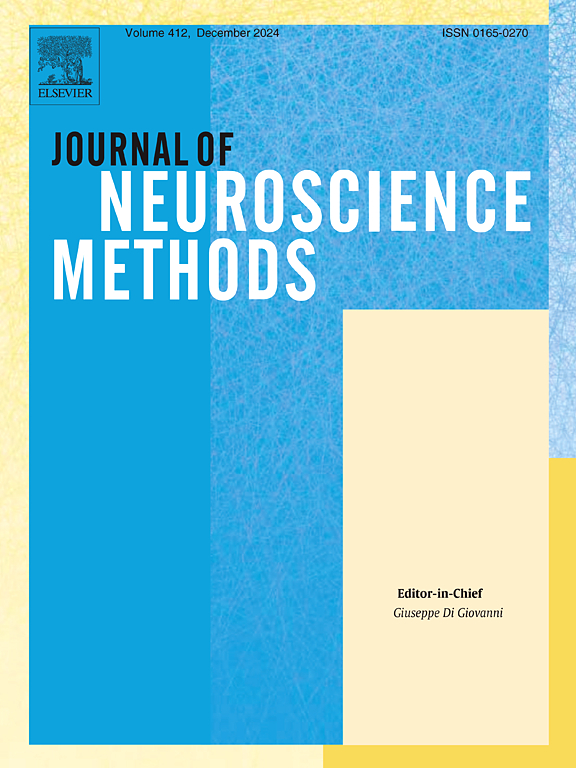简化小鼠DRG固定、加工和F4/80免疫组织化学的综合方案:克服共同挑战
IF 2.3
4区 医学
Q2 BIOCHEMICAL RESEARCH METHODS
引用次数: 0
摘要
背根神经节(DRGs)包含感觉神经元和非神经元细胞的细胞体,在疼痛性炎症(如神经性疼痛)的病理生理中发挥作用。免疫组织化学(IHC)是可视化和定量DRGs中免疫细胞标记的有价值的工具,为这些机制提供了重要的见解。然而,由于DRGs体积小且位于脊柱内,因此在分离DRGs的同时保留细胞形态进行IHC染色在技术上具有挑战性。目的利用单核-巨噬细胞标志物F4/80,优化了福尔马林固定石蜡包埋(FFPE)小鼠DRGs的固定、收获、处理和免疫组化染色方案。该方法旨在保持组织完整性并确保与下游组织病理学分析的兼容性。新方法分离DRG前,将小鼠整个脊柱置于10 %中性缓冲福尔马林中,室温固定24 h。DRGs处理9 h,并使用蛋白酶k进行抗原回收。结果优化的浸泡固定方法保留了细胞形态和抗原性,确保了高质量的组织学结果。虽然经心肌灌注仍然是组织固定的金标准,但它耗时,需要培训并引起伦理问题。我们优化的全脊柱固定与随后的组织分离的方法是非侵入性的,与分离后的固定相比,减少了死亡和固定之间的时间。此外,它提供的组织学质量可能与基于灌注的技术相当。结论该方案有评分系统支持,以帮助评估变量并选择最适合实验目标的条件。本文章由计算机程序翻译,如有差异,请以英文原文为准。
A comprehensive protocol for simplified mouse DRG fixation, processing and F4/80 immunohistochemistry: Overcoming common challenges
Background
Dorsal root ganglia (DRGs) contain the cell bodies of sensory neurons and non-neuronal cells that play a role in the pathophysiology of painful inflammatory conditions, such as neuropathic pain. Immunohistochemistry (IHC) is a valuable tool for visualising and quantifying immune cell markers in DRGs, providing important insights into these mechanisms. However, isolating DRGs while preserving cell morphology for IHC staining is technically challenging due to their small size and location within the spinal column.
Objective
Using F4/80, a pan monocyte-macrophage marker, we present an optimised protocol for the fixation, harvesting, processing, and IHC staining of formalin-fixed-paraffin-embedded (FFPE) mouse DRGs. This method is designed to maintain tissue integrity and ensure compatibility with downstream histopathological analysis.
New Method
The entire spinal column of mouse was fixed in 10 % neutral-buffered formalin at room temperature for 24 h before DRG isolation. DRGs were processed for 9 h, and antigen retrieval was performed using proteinase K.
Results
The optimised immersion-fixation approach preserved cellular morphology and antigenicity, ensuring high-quality histological outcomes.
Comparison with Existing Methods
While transcardial perfusion remains the gold standard for tissue fixation, it is time-intensive, requires training and raises ethical concerns. Our optimised method of whole spinal column fixation with subsequent tissue isolation is non-invasive and reduces the time between death and fixation in comparison to post-isolation fixation. Additionally, it delivers histological quality likely comparable to that of perfusion-based techniques.
Conclusion
This protocol is supported by a grading system to help evaluate variables and select conditions best suited to their experimental goals.
求助全文
通过发布文献求助,成功后即可免费获取论文全文。
去求助
来源期刊

Journal of Neuroscience Methods
医学-神经科学
CiteScore
7.10
自引率
3.30%
发文量
226
审稿时长
52 days
期刊介绍:
The Journal of Neuroscience Methods publishes papers that describe new methods that are specifically for neuroscience research conducted in invertebrates, vertebrates or in man. Major methodological improvements or important refinements of established neuroscience methods are also considered for publication. The Journal''s Scope includes all aspects of contemporary neuroscience research, including anatomical, behavioural, biochemical, cellular, computational, molecular, invasive and non-invasive imaging, optogenetic, and physiological research investigations.
 求助内容:
求助内容: 应助结果提醒方式:
应助结果提醒方式:


